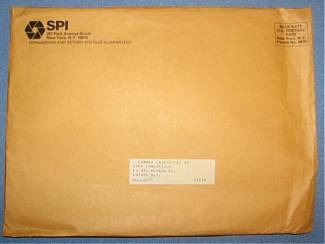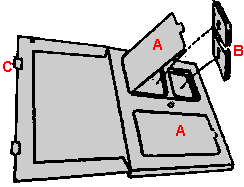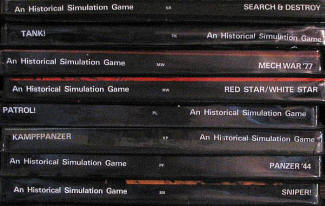|
|
SPI Game Boxes/Containers
Greg Costikyan has
recorded online the major details of publication states of
SPI games; what follows is a
summary of his information regarding boxes, with photos of items in
the webmaster's collection. The original article is located at
this URL. SPI produced games as both stand alone titles and in
their magazine,
Strategy & Tactics (S&T).
|
Envelope
The manila envelope was used for
the earliest games sold by SPI, the Test Series Games. Even
afterwards, some games such as Strike Force One did not
have boxes produced for them.
|
 |
| Magazine
Magazine games (in either Ares,
the science-fiction magazine, or S&T) were released directly
in the pages of the magazine itself. As noted above, counters
were not mounted until issue 26 (and some back issues were
released later with mounted counters made available
retroactively), and the practice of making magazine games also
available as boxed items did not commence until July 1973
(though not for all titles, and the practice was halted again
in SPI's final months due to financial concerns). The method
of combining the game and the magazine differed; some were
bound directly into the magazine, others were simply inserted
loosely, and some print runs had a mixture. |
 |
| White Box
The first box introduced by SPI
was a folded cardboard container released in September 1972 as
standard for all games. The only differentiation between
different games was a printed red label which was applied
afterwards.
 |
 |
|
The boxes measured 12" x 15" x
7/8" and had a hinged flap. The inside of the flap was
designed to hold mapsheets and rules folders/booklets and
other flat game play aids (such as pads of plotting sheets,
for example). The bottom of the box had recessed wells for
holding counters, accessed by flaps which had die-cut finger
holes. According to Costikyan: "At
first, no plastic storage tray was included in the white
boxes; instead, there was a (corrugated) cardboard insert
which was supposed to create two large compartments for
counter storage under the pull-ups. This did not work worth a
damn, as the counters easily slipped around under the
cardboard insert."
A plastic
counter tray was developed, and for three months of production
became a standard insert for the white box beginning in April
1973. After that time, production shifted to the "Black Box",
with the counter tray forming the basis of the new delivery
method, with a cardboard bottom added. Again, according to
Costikyan: "it is rare to find SPI games in white boxes
without counter trays, as most gamers quickly bought extra
trays for the older games. At this time, magazine games could
normally either be bought as "back issues" with no box, or as
White Box games, with the magazine thrown into the box along
with other components." |
 |
 |
| Printed Box
The "White Box" style was
occasionally issued in full colour print with front cover and
inside artwork on the box. At right is shown the Normandy
title (not a tactical level game). Only a select few games
were selected for this treatment in order to make them more
attractive for retail display; Costikyan points out that at
the time these boxed versions were released (he lists
Normandy (1971), Leipzig (1969) and Barbarossa
(1969) as examples but doesn't say when exactly the printed
boxes were produced) SPI was largely a mail order business.
The black plastic tray insert can be seen in the picture at
right as well. |
 |
|
Black Box
The "Black Box" style debuted in
July 1973, replacing the awkward white boxes and using the
counter trays which were initially developed as inserts for
the white boxes. This style of container became the standard
and was used for most games through June of 1978.
This insert
became the basis of the box itself. To the back was glued a
heavy piece of heavy black cardboard, to act as a stiffener.
The so called "monster
games" (SPI apparently defined these as having two
or more maps and at least 800 counters) were packaged in two
such black boxes, shrink-wrapped together with the top faces
touching. "Normally, there were two paper cover sheets: one
color for the top box, one black-and-white with descriptive
text for the bottom. The package usually had several plastic
loops, to hold the two boxes together for storage after the
shrink-wrap was removed." |
 |
|
Black
Plastic Counter Tray and Lids
The container
itself served as the bottom of the "box" and had two clear
plastic lids. There was no catch or other device to keep these
lids in place, and only gravity assisted in holding the box
together. According to Costikyan, "This worked only
indifferently well. The earliest black boxes had plastic lids
with "wings" that fit over the center wells of the black
(tray); the lids in later black boxes had no "wings"." At
right is a "wing-less" set of lids. |
 |
|
Cardboard
Backing
The bottom of
the counter tray was reinforced with a piece of stiff black
cardboard glued into place; collectors will find this piece is
sometimes missing, or often pulling apart from the rest of the
box. |
 |
|
Plastic Lid
The top of the box was a clear
plastic lid; some in collections are starting to show their
age and are discolouring and cracking, especially those left
in the sun or exposed to ultraviolet light.
|
 |
|
Cover Sheet
A cover sheet printed on slick
paper was slipped over top of the game's contents - mapsheet,
countersheet, and the counter tray - and sandwiched in by the
clear plastic lid. |
 |
|
Each cover sheet had a printed
title where the flat end of the box was, so it could be read
when sitting on a retailer's shelf. |
 |
|
The cover sheet extended to the
back of the box, where it was shrink-wrapped in place. The
bottom section contained information about the game as an
enticement to buying to retail customers. Once the shrink-wrap
is removed, collectors are challenged with how to deal with
this piece and it is often seen damaged or removed.
Plastic Loop
The final component was a
"plastic loop" used to keep the box top and the bottom
together in storage. The several of these were used for the
"monster game" packages described above. |
 |
|
Accordion Box
In June 1978, the Black Box was
replaced with a nesting style box very similar to Avalon
Hill's "Bookcase Game" boxes. The Black Box had been an
unusual choice of packaging; retailers found it hard to
shelve, according to Costikyan. The advantage to the Black Box
was that it required no special printing and could be mass
produced. The move to custom boxes led to an increased demand
for warehouse space, "increasing investment in inventory. Not
good things for a company that lived on the edge of bankruptcy
in the first place." While the box tops were printed, the
bottoms were usually blank. Information sheets were printed
and shrink-wrapped to the bottom instead. The new box had an
improved counter tray with a clear plastic lid. Indentations
on the outer edges of the compartments helped keep the lid
snapped onto the bottom compartment to prevent counters from
spilling out.
The standard box was 11" x 9" x
2" deep, with "monster games" coming in a 4" size and smaller
games being issued in a special 1" size box (usually without a
counter tray in the latter and normally two in the former).
The 4" box was nicknamed a "detergent box" because of its
large size and passing similarity to the domestic item of the
same name. An example of one of these "monsters" was
MechWar2 with 1600 counters and multiple maps.
|
 |
 |
|
Other Formats -
There were some other less
commonly used formats of delivery also:
Ziploc
All games sold in Black Box,
doubled Black Box, Accordion Box and Folio (see below)
containers were also sold in ziploc containers, without either
any kind of box or counter trays. This reduced the overall
cost to the consumer. The Black Box (and double Black Box)
games still shipped with their paper cover sheets, while the
Accordion Box and Folio games did not come with descriptive
text. Some games were sold by SPI only in this format.
Mounted Accordion Box
To increase their revenue via
retail, some games were provided with mounted mapboards. This
was an early effort to increase sales, and was done with a
select number of titles. The box was a 9" x 12" x 2" box with
printed cover sheets glued to the exterior; these games are
distinguishable also by
-
having hard mounted mapboards
-
having counter trays without
plastic lids
-
having printed back covers
-
dating from before June 1978,
the date which all SPI games started to appear in the
standard accordion style boxes
Folio
This was a simple printed
cardboard folder designed with a pocket inside to hold the
contents, generally a 17" x 22" mapsheet and 100 counters.
These were discontinued in the late 1980s.
Capsule
Capsule format games were sold
beginning in March 1979; these were simple plastic bags with
flaps taped closed. While later releases had a separate cover
sheet, earlier versions had the sheet information printed
directly on the back of the folded mapsheet itself (usually an
11" x 17" or 17" x 22" map). These games, like the folio style
games, also contained about 100 counters. They were replaced
by the 1" accordion box containers circa March 1980 in
response to complaints from retailers wanting something easier
to display and harder to steal. |
|
|
|
Timeline
|
1968 |
|
SPI purchases S&T, begins
publishing wargames. All counters are unmounted and games
are sold in manila envelopes. |
|
March 1971 |
|
Beginning with Issue 26 of S&T,
all counters are mounted, including those printed for sale
with back issues of magazines. |
|
September 1972 |
|
The first box is introduced to
sell games in; it consists of a plain white folded cardboard
box with the name of the game printed on a red label applied
to the front. Inside the front cover is a sleeve to hold
rules and map, and the bottom contains wells for counters
and a die. |
|
April 1973 |
|
Plastic counter trays are
introduced for the White Box, as well as made available for
separate sale. According to Costikyan, "anyone with any
sense bought them immediately to put them in their older
white box games. Hence, few (white boxes without trays) are
seen today." |
|
July 1973 |
|
Games are issued in the Black Box
described below, and magazine games are discontinued as part
of back issue sales. Magazine games became available in
boxed form the same as other non-magazine games after the
magazine's date of publication. The white box was deleted
entirely from all production runs of in print SPI titles. |
|
June 1978 |
|
Introduction of the 2" Accordion
Box format for larger games, replacing the Black Box. |
|
February 1979 |
|
Smaller games (described as
"folio" and "capsule" games by Costikyan) were published in
Folio format up to this date, and in Capsule format
beginning in February 1979. The 1" Accordion Box format was
introduced in March 1980 for these games. |
|